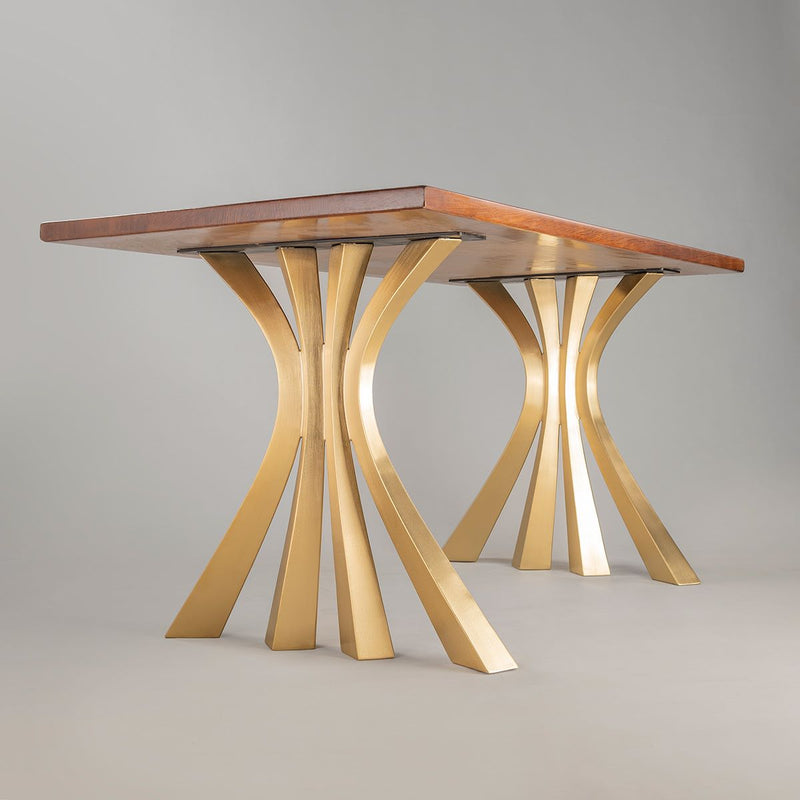An In-depth Take A Look At Table Leg Styles: Finding the Perfect Match
Picking the best dining table leg design is essential for both visual charm and practical capability. Typical 4 legs provide classic style and stability, while the stand base offers boosted legroom and a modern-day appearance. For those with larger tables, trestle legs make certain durable assistance, whereas hairpin legs present a mid-century contemporary ambiance with their minimalist design. The x-shaped legs blend contemporary design with improved security. Each of these choices brings special advantages, making the choice greater than just a matter of choice. Explore further to uncover which design completely complements your dining room and lifestyle.
Typical 4 Legs
Among the numerous kinds of dining table leg styles, the standard four-leg design remains a classic selection for lots of families. 4 legs give balanced support, guaranteeing the table stays stable and qualified of birthing substantial weight (dining room table legs).
From a visual point of view, the conventional four-leg layout can be easily adjusted to various interior styles. Whether crafted from wood, metal, or a mix of materials, these legs can be elaborately carved, smooth and minimalistic, or anything in between. Their versatility permits them to enhance both rustic and modern setups effortlessly.
Additionally, the straightforward structure of the four-leg design promotes convenience of movement and positioning within a room. Unlike even more complicated bases, this design lessens blockages, offering ample legroom for restaurants. In recap, the conventional four-leg table leg design marries enduring sophistication with useful functionality, making it an astute option for those looking for both kind and feature in their eating furniture.
Stand Base
Commonly commemorated for its elegant and space-efficient layout, the pedestal base is a recognized option to the conventional four-leg setup in dining table leg designs. This distinctive base commonly includes a single main column sustaining the tabletop, which can differ in type, from ornately carved timber to sleek, modern-day metal. Among the key benefits of the pedestal base is its ability to take full advantage of legroom and seating flexibility. Without corner legs, diners are afforded higher freedom of movement, making it an optimal selection for round and oblong tables that advertise even more intimate and inclusive gatherings.
The main column itself provides a canvas for detailed styles and creative expressions, adding a component of aesthetic passion under the table. In summary, the pedestal base incorporates capability with style, making it a fine-tuned and practical option for varied eating atmospheres.
Trestle Legs
Trestle legs provide a robust and timeless structure for dining tables, characterized by their horizontal cross-bracing and tough assistance beam of lights. Stemming from middle ages times, this layout has actually developed yet retained its crucial structure, making it a perennial favorite in both typical and modern settings. The main trestle beam, commonly sustained by 2 or more upright articles, supplies remarkable security, permitting larger table sizes without the demand for added legs.
A considerable advantage of trestle leg tables is the adequate legroom they supply. Unlike tables with four edge about his legs, the lack of blockages at the table's sides supplies unblocked space for chairs and diners, boosting comfort and availability. This makes trestle tables excellent for suiting bigger celebrations, whether in a dining-room or a banquet hall.
The visual versatility of trestle legs is noteworthy. Readily available in a range of materials such as timber, steel, and composite, they can be finished to match a large variety of interior designs. From rustic farmhouse to sleek modern layouts, trestle legs can be customized to suit individual preferences. Their long-lasting appeal and functional advantages make trestle legs a compelling option for those seeking both design and practicality in their table.
Barrette Legs

The allure of hairpin legs hinges on their simpleness and convenience - dining room table legs. Offered in a series of materials, including steel and brass, they can be ended up in countless colors to complement various interior styles. Whether coupled with a rustic wooden tabletop or a contemporary glass surface, barrette legs easily mix capability with a touch of classic appeal
Toughness is an additional significant feature check my site of hairpin legs. Despite their fragile look, these legs are crafted to birth considerable weight, ensuring the table stays secure and protected. Furthermore, they are reasonably easy to mount, making them a popular option for do it yourself fanatics and expert furniture manufacturers alike.
X-Shaped Legs

Constructed from products such as steel, wood, or a mix of both, X-shaped legs can be customized to match numerous design preferences. Steel legs frequently provide a smooth and commercial feel, suitable for loft-style apartments and modern eating areas. On the other hand, wood X-shaped legs provide a warmer, a lot more rustic appeal, appropriate for farmhouse or diverse interiors. The flexibility in products enables home owners to tailor their dining tables to much better fit their total layout scheme.
In addition, the design behind X-shaped legs makes certain even weight circulation, decreasing the danger of wobbling and enhancing resilience. This makes them particularly appropriate for bigger eating tables that call for extra assistance. Fundamentally, X-shaped legs blend functional engineering with modern-day aesthetic appeals, making them a classic option for diverse eating settings.
Conclusion
An extensive understanding of table leg styles reveals the unique qualities and advantages of each layout. Conventional 4 legs offer stability and timeless appeal, while pedestal bases offer legroom and a structured appearance. Trestle legs guarantee durable assistance for larger tables, and barrette legs introduce a see post mid-century modern aesthetic. X-shaped legs combine modern design with enhanced security. Picking the ideal leg design guarantees both functional and visual satisfaction in any type of eating room.